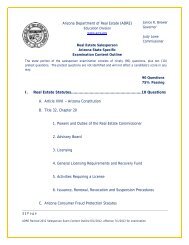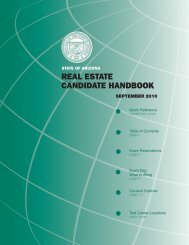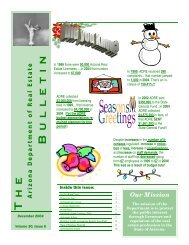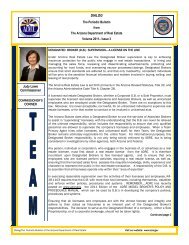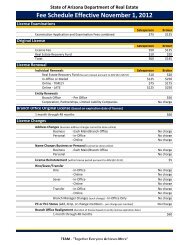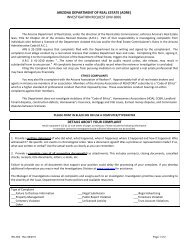Law Book - Arizona Department of Real Estate
Law Book - Arizona Department of Real Estate
Law Book - Arizona Department of Real Estate
You also want an ePaper? Increase the reach of your titles
YUMPU automatically turns print PDFs into web optimized ePapers that Google loves.
119 CHAPTER 28. STATE REAL ESTATE DEPARTMENT R4-28-A1204<br />
4. Monuments, distances, and bearings; and<br />
5. Registered land surveyor certification.<br />
B. The applicant shall identify the location <strong>of</strong> the development, including the street, city, county, and state,<br />
and:<br />
1. The miles and direction from the nearest city or town, if applicable; and<br />
2. The most direct route for getting to the development from a federal, state, county, or city road.<br />
C. The application shall include a description <strong>of</strong> the physical characteristics <strong>of</strong> the land and any unusual<br />
factors that may affect it, such as if it has level or hilly terrain, rocky, loose, or alkaline soil, and<br />
1. The gross acreage <strong>of</strong> the development;<br />
2. The total number <strong>of</strong> lots within the development, including a description <strong>of</strong> phasing, if applicable; and<br />
3. Whether and how lots are permanently or temporarily staked or marked for easy location.<br />
Historical Note<br />
Section R4-28-A1202 adopted by final rulemaking at 5 A.A.R. 650, effective February 3, 1999 (Supp. 99-1).<br />
R4-28-A1203. Flood and Drainage; Land Uses; Adverse Conditions<br />
The applicant shall state, or include as applicable:<br />
1. Whether the development is subject to any known flooding or drainage problems and a letter bearing<br />
the signature and seal <strong>of</strong> a pr<strong>of</strong>essional civil, city, and county engineer, or county flood district<br />
detailing the drainage conditions and flood hazards. The letter shall include the effect <strong>of</strong> any flood<br />
plain and its location, the effect <strong>of</strong> a 100 year frequency storm, and whether flood insurance is<br />
required.<br />
2. Whether the development lots are subject to subsidence or expansive soils. If subsidence or expansive<br />
soils exist, a pr<strong>of</strong>essional engineer’s letter addressing the effects <strong>of</strong> the condition, remedies, and a<br />
buyer’s on-going responsibilities in plain language;<br />
3. A description <strong>of</strong> the existing and proposed land uses in the vicinity <strong>of</strong> the development that may cause<br />
a nuisance or adversely affect lot owners, such as freeways, airports, sewer plants, railroads, and<br />
canals, including:<br />
a. Any unusual safety factors within or near the development, and<br />
b. A description <strong>of</strong> all current and proposed adjacent land uses.<br />
4. Whether the development is affected by any unusual or unpleasant odors, noises, pollutants, or other<br />
nuisances;<br />
5. A description <strong>of</strong> any agricultural activity or condition in the area that may adversely affect a lot owner,<br />
including any odors, cultivation and related dust, agricultural burning, application <strong>of</strong> pesticides, or<br />
irrigation and drainage;<br />
6. Whether the development lots are subject to any known geological or environmental condition that<br />
would or may be detrimental to a purchaser’s health, safety, or welfare; or<br />
7. Whether the development lots are located within the boundary <strong>of</strong> a federal, designated Superfund site<br />
or a state designated Water Quality Assurance Revolving Fund site.<br />
Historical Note<br />
Section R4-28-A1203 adopted by final rulemaking at 5 A.A.R. 650, effective February 3, 1999 (Supp. 99-1).<br />
R4-28-A1204. Utilities<br />
The applicant shall include information about electrical, telephone, and natural gas utilities available to the<br />
development, including:<br />
1. The names, addresses, and telephone numbers <strong>of</strong> the electrical, telephone, and natural gas company<br />
that will provide service;<br />
2. The location <strong>of</strong> existing electrical, telephone, and natural gas utilities in relation to the development;<br />
3. The name <strong>of</strong> each person responsible for extending each utility to the lot lines;<br />
4. The estimated completion date for extending each utility to the lot lines;<br />
5. If the developer will only install conduit, a description <strong>of</strong> the arrangement made to complete operational<br />
utilities to lot lines;<br />
6. The estimated cost a lot purchaser will be required to pay for completion <strong>of</strong> each utility to the<br />
purchaser’s lot line, and, if the <strong>of</strong>fer is for unimproved lots, the estimated costs to provide service from<br />
the lot line to the dwelling;<br />
7. Upon completion <strong>of</strong> the utilities, other costs or requirements that must be addressed before the lot<br />
purchaser receives service, including the current service charges, hookup fees, turn-on fees, meter<br />
fees, and fees for pulling wire through conduit;<br />
8. If propane gas will be used, a letter from the supplier stating that it will be providing service to the<br />
development, with a description <strong>of</strong> requirements to be met and costs to be paid by the lot purchaser<br />
for receiving the service; and



